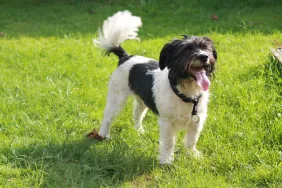
Is there anything more difficult to resist than puppy-dog eyes?
Whether your dog has been doing something they shouldn’t have, or they’re hankering for extra treats, when they bring out those puppy dog eyes you’re likely to stop what you’re doing and give them just what they want.
But, why do dogs make puppy-dog eyes, and why can’t we resist them? Here’s what the science has to say.
The evolution of puppy-dog eyes
Dogs evolved eyebrows over time. Of course, we humans use the small muscles in our face – particularly around our eyes and mouth – to communicate and make quick facial expressions, like raising an eyebrow.
They’re called mimetic muscles, and they’re powered by fast-twitch fibers that get tired quickly – this is why we can’t hold certain expressions for too long.
Researchers looked at how dogs and wolves use their own mimetic muscles, Dogs tend to use fast-twitch fibers rather than slow-twitch fibers between 66 percent and 95 percent of the time, whereas for wolves it’s only about 25 percent, according to Smithsonian.
When dogs evolved from wolves thousands of years ago, their need for slow-twitch fibers probably decreased. And over time, their facial expressions became more akin to what we know today.
They may have evolved these fast-twitch muscles to allow them to make the shorter barks everybody is familiar with, rather than the howls we associate with wolves.
And it’s likely that humans played a role in helping puppy dog eyes evolve with selective breeding. “Throughout the domestication process, humans may have bred dogs selectively based on facial expressions that were similar to their own,” said anthropologist Professor Anne Burrows in a statement, per CNN.
How eyebrow muscles help dogs communicate
Dogs use their eyebrows to convey emotions, just like humans. This is thanks to the evolution of fast-twitch fibers in their face.
For example, when dogs meet somebody’s gaze, they’ll sometimes raise their inner eyebrow muscle. This makes their eyes look larger, something that humans are wired to find cute.
“There’s no evidence that dogs move this [eyebrow] muscle intentionally, but it creates an exaggerated movement that for us means ‘dog’,” explains study leader Juliane Kaminski, a psychologist at the University of Portsmouth, to National Geographic.
In the past, Kaminski’s research has led her to find that dogs are brilliant at understanding and reading humans – even outperforming chimpanzees. But what about the other way around?
A decade ago, Kaminski filmed shelter dogs to find out whether any particular behaviors were linked to how fast the animals were adopted. The only one that stood out was the upward and inward movement of the dog’s eyebrows.
Between dogs, eye contact indicates aggression. Of course, this isn’t the case with humans. But dogs were able to learn that humans reward eye contact. When a dog breaks eye contact with another dog, it could mean that a fight will break out. But dogs are comfortable breaking eye contact with humans – it shows a rapport between dog and owner.
When a dog blinks or squints, it might mean that he’s thinking about what you’re thinking. You might see your pup blinking if you’ve just given them a command, for example.
But what if your dog avoids eye contact? They might have trust issues, and they’re doing their best to avoid any kind of interaction with humans. Often, this will be seen in rescue or shelter dogs, or dogs who’ve previously been abused or neglected.
Understanding your dog’s body language
Now that you know how puppy-dog eyes evolved, learn more about what your dog’s ear position means and the reasons your dog’s tongue sticks out!









